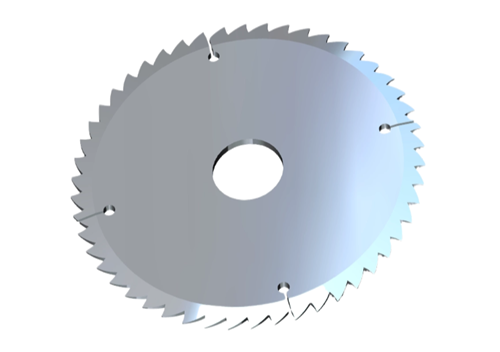Carbide Saw Blade Maintain and Use
1.Proper installation is crucial.
Before installation, carefully clean the cemented carbide saw blade and the mounting area of the equipment to ensure they are free of debris and dust. For example, when installing on a table saw, clean the saw shaft to ensure it is free of rust and other foreign matter. Ensure the saw blade is oriented correctly during installation. The saw blade will typically have an arrow marked on it; the arrow should align with the direction of rotation during cutting. Installing the saw blade in the wrong direction will not only result in poor cutting results, but may also damage the blade and even cause danger.
2.Inspect the saw blade before use.
Check the blade for any damage, such as chipping or cracks in the teeth. If any chipping is detected, even minor, replace the blade or repair the chip immediately. Continued use of a defective saw blade will compromise cut quality, resulting in uneven edges, which may worsen as the cut progresses.
3.Choose appropriate cutting parameters.
Adjust the cutting speed and feed rate based on the material and thickness of the material being cut. For harder materials, such as stainless steel, the sawing speed should be slower and the feed rate should be lower, approximately 200-300 mm per minute. For softer woods, the sawing speed can be increased to a feed rate of 500-800 mm per minute. Improper parameter selection, such as excessive sawing speed, can cause the saw blade to overheat and increase wear; excessive feed rate can put excessive pressure on the saw blade, causing damage to the teeth.
4.Keep the saw blade clean.
During the sawing process, the saw blade will pick up impurities such as sawdust and debris. Regularly cleaning these impurities will ensure the saw blade’s cutting performance. Use a dedicated cleaning tool, such as a soft-bristle brush, to gently brush away impurities on the saw blade surface after the saw stops. If the saw blade becomes stained with oil, it can be cleaned with an appropriate amount of detergent, but be careful not to use highly corrosive detergents to avoid damaging the saw blade.

5.Pay attention to the sawing environment.
Keep the sawing environment dry and clean. Avoid using saw blades in humid environments, as this can easily cause rust. Also, keep the work area clean and free of debris that could obstruct the saw blade’s operation. For example, when working outdoors, debris such as branches and rocks could strike the saw blade during operation, causing damage.
6.Lubricate the saw blade regularly.
To reduce friction and wear during sawing, use a dedicated lubricant. Generally, apply a suitable amount of lubricant to the teeth and surface of the saw blade after a certain amount of sawing time or after cutting a certain amount of material. For example, lubricate after every 100-150 cuts. The lubricant forms a protective film between the saw blade and the material, reducing friction and extending the life of the saw blade.
7.Avoid overloading the saw blade.
Never operate beyond the specified cutting capacity of the saw blade. For example, if the maximum cutting thickness of a saw blade is 50 mm, never cut materials thicker than this. Overloading the saw blade can put extreme pressure on it, causing deformation, tooth damage, and even accidents.
8.Store saw blades properly.
When not in use, store them in a dry, well-ventilated area. Ideally, use a dedicated saw blade storage rack and store them vertically to prevent them from being squeezed or colliding with each other. Stacking saw blades carelessly can damage the teeth. Place a soft mat on the saw blade storage rack to provide cushioning and protection.
9.Check the tension of the saw blade regularly.
The tension of a saw blade may change over time. Uneven tension can affect the accuracy and quality of the sawing. Use a professional tension tester to check the tension of the saw blade. If the tension is not as required, adjust it promptly. Generally, tension checks should be performed approximately every month.
10.Sharpen the saw blade.
When the teeth of a saw blade are worn to a certain extent, sharpen them promptly. Sharpening restores the sharpness of the teeth and improves cutting performance. You can take your saw blade to a professional sharpening shop or perform it yourself using specialized sharpening equipment. For example, consider sharpening a saw blade after 200-300 hours of use.
11.Protect the saw blade from severe impact.
Handle the saw blade carefully during transportation and installation to avoid dropping or impacting it. For example, handle the saw blade gently when removing it from the packaging box. During installation, operate the saw blade steadily to prevent it from colliding with other hard objects. Severe impacts on the saw blade can cause internal cracks, affecting its performance.
12.Keep records of saw blade usage.
Record the blade’s usage time, the type and amount of material cut, and any problems encountered. This record allows you to understand the blade’s usage and determine whether it needs maintenance, sharpening, or replacement. For example, if the records show that the blade wears significantly faster after cutting a certain material, you can make appropriate preparations and adjustments the next time you cut a similar material.
Our company is a professional tungsten carbide disc blanks manufacturer. Should you require cemented carbide products, please contact us(info@wolframcarbide.com).
